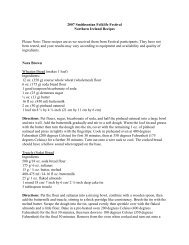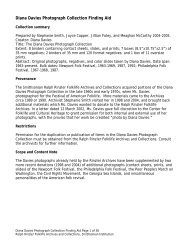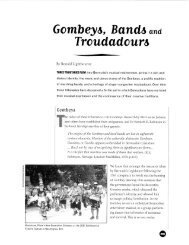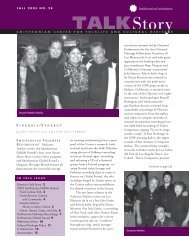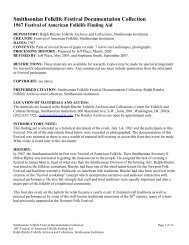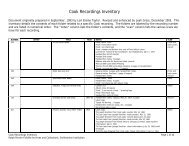Who Owns Traditional Medical Knowledge? - Smithsonian Center ...
Who Owns Traditional Medical Knowledge? - Smithsonian Center ...
Who Owns Traditional Medical Knowledge? - Smithsonian Center ...
Create successful ePaper yourself
Turn your PDF publications into a flip-book with our unique Google optimized e-Paper software.
182 SITA REDDY<br />
11. Foucault, Discipline and Punish, in which he distinguishes between sovereign and disciplinary<br />
power in surveillance techniques. See also his notion of biopower that he begins to lay out in Birth of<br />
the Clinic.<br />
12. See Zimmermann, Jungle and the Aroma of Meats; and Wujastyk, The Roots of Ayurveda, for<br />
more on classical Ayurveda, which relies on humoral diagnostics and a therapeutic armamentarium<br />
that involves a combination of internal medicine (kayachikitsa), herbal remedies (dravyaguna), and<br />
rejuvenation programs (rasayana). See Leslie and Young, Paths to Asian <strong>Medical</strong> <strong>Knowledge</strong>; and Langford,<br />
Fluent Bodies, for more on contemporary Ayurvedic practice, which in South Asia reflects a<br />
long history of professionalizing reform of this medical tradition as part of a larger nationalist project<br />
of indigenous revival. See also Reddy, Reinventing <strong>Medical</strong> Traditions, and “Asian Medicine in America,”<br />
for more recent transformations of Ayurveda in the United States. For more on the nationalist<br />
project and its effects on the cultural sphere, see Chatterjee, The Nation and its Fragments.<br />
13. Don Bates, ed. <strong>Knowledge</strong> and the Scholarly <strong>Medical</strong> Traditions.<br />
14. Brown, “Can Culture Be Copyrighted,” 193–222.<br />
15. Deborah Root, Cannibal Culture, offers an early analysis of the escalation of moral panic with<br />
biocolonialism.<br />
16. Brown “Heritage Trouble.”<br />
17. Brown, “Heritage Trouble”; Sunder, “Intellectual Property and Identity Politics” and “Cultural<br />
Dissent”; Coombe, The Cultural Life of Intellectual Properties; and Cowen, Creative Destruction.<br />
18. See for example, Brown, “Heritage Trouble,” 46; Barsh, How do you Patent a Landscape; and<br />
Posey and Dutfield, Beyond Intellectual Property. For a more general description of the same process<br />
with indigenous knowledge, see Agrawal, “Indigenous <strong>Knowledge</strong> and the Politics of Classification.”<br />
19. Parry, Trading the Genome, 24.<br />
20. Marilyn Strathern, Property, Substance and Effect.<br />
21. Reddy, Reinventing <strong>Medical</strong> Traditions, Chapter 7.<br />
22. For comprehensive histories of Ayurveda’s professionalization, see Leslie and Young, Paths to<br />
Asian <strong>Medical</strong> <strong>Knowledge</strong>; Leslie, Asian <strong>Medical</strong> Systems; Bala, Imperialism and Medicine; and Langford,<br />
Fluent Bodies. For a longer history of Ayurveda’s heterodox origins, see Zimmermann, The<br />
Jungle and the Aroma of Meats; Zysk, Asceticism and Medicine; and Wujastyk, The Roots of Ayurveda.<br />
23. Appadurai, Modernity at Large, 6.<br />
24. Merryman, “Two Ways of Thinking about Cultural Property,” 836.<br />
25. Scott, Seeing Like a State, 31–32.<br />
26. For a good overview, see Mitchell, The Rule of Experts. For the process of cultural production<br />
through colonialism in South Asia, see Dirks, Castes of Mind.<br />
27. CSICH, 2003.<br />
28. Watkins, “Cultural Nationalists, Internationalists and ‘Intra-nationalists’.” For an overview of<br />
enclosures in the public domain, see Boyle, “The Second Enclosure Movement.” For a description of<br />
how enclosures exploit traditional knowledge, see Shiva et al., “The Enclosure and Recovery of the<br />
Commons.”<br />
29. The shift in global cultural disputes from the protracted dispute over stolen bronze icons in<br />
the 1980s is described in Davis, Lives of Indian Images; and Weil, “<strong>Who</strong> <strong>Owns</strong> the Nataraja” The<br />
more recent Neem campaign and the turmeric wars is described in Shiva, “The Neem Campaign.”<br />
30. For a general description of Ayurveda’s twentieth-century professionalizing failures based on<br />
practice, see Leslie and Young, Paths to Asian <strong>Medical</strong> <strong>Knowledge</strong>. See also Langford, Fluent Bodies,<br />
for the recent shift to national disputes over Ayurvedic knowledge.<br />
31. Benjamin, “The Work of Art in the Age of Mechanical Reproduction,” 221.<br />
32. Brown, “Heritage Trouble”; Chander and Sunder, “Romance of the Public Domain.”<br />
33. See Lessig, Free Culture; and Boyle, Shamans, Software and Spleens, for early expositions of<br />
this argument.<br />
34. Hayden, When Nature Goes Public.<br />
35. Chander and Sunder, “Romance of the Public Domain,” 1335.<br />
36. For a good historical introduction to Van Rheede and his text, see Heniger, Hendrik Adriaan<br />
van Rheede tot.



